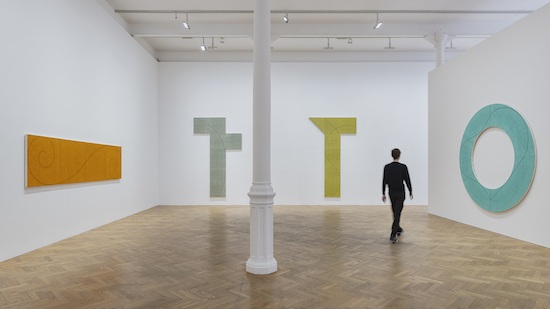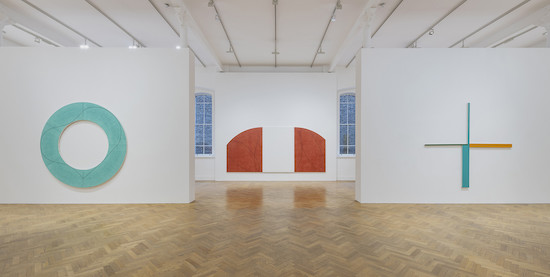Installation view, Robert Mangold: A Survey 1981–2008, April 12 – May 22, 2021, Pace Gallery, London © ARS, NY, & DACS, London, 2021. Photo: Damian Griffiths. Courtesy Pace Gallery
Robert Mangold and Sol LeWitt used to work at the Museum of Modern Art in New York. Not as curators or anything. They were security guards. If you went to see the Frank Lloyd Wright drawings there in the spring of ‘62, it would have been Mangold and LeWitt making sure you didn’t walk off with any of them. Lucy Lippard, who’d also worked there, in the library, called them the ‘Bowery Boys’ – Mangold and LeWitt and Robert Ryman. They all lived in these huge lofts out below Cooper Square in the Lower East Side. It was a pretty rundown area at the time. Most of the bars in the district had shut down during Prohibition and somehow never quite got round to opening again. Mostly there were restaurant supply shops and cheap clothing outlets. “There were not many places to go,” Mangold would recall in an interview with Shirley Kaneda for Bomb in 2001, “no bars or hangouts that I recall outside of Moishe’s, a deli.”
At night, after coming home from work at the museum, he would stare out through the big open windows up high in the sprawling ex-industrial space he called home, gazing out at the city. La nuit, as the saying goes, tous les chats sont gris. All cats are grey and all tall buildings are just so many interlocking rectangles. Slabs of gleaming light and inky darkness. Each one poking out over the other. But it wasn’t so much the buildings themselves that caught Mangold’s eye – not the Empire State or the Chrysler or even Frank Lloyd Wright’s auto-showroom on 430 Park Avenue. It was the jagged, cut-out spaces in-between them. “What struck me,” he said of that time, “was that so much of what we see, we see in fragments. We see part of a truck going by, or part of a building. We never see anything in completeness.”
It can be tough, sometimes, to get someone to see the most obvious thing in front of them. Faced with a painting by Vermeer, spectators will generally be inclined to impute all sorts of psychological motivations to the figures within the frame, develop complex backstories for each of them, before they’ll talk about how very blue the painting is, how big it is, how the canvas itself is a rectangle. For John Locke in the seventeenth century, things like shape and magnitude were primary qualities, immediate facts of existence. But most of the time nothing could be further from the truth. The mind thinks in chunks, grasps at assemblages and composites. It’s a coffee-table before its a hollow cuboid perched on four spheres. It’s marinara with a tad too much salt before it’s red liquid. But Robert Mangold’s paintings will force you to see colour, shape, extension. “To look at any painting by Robert Mangold,” Shirley Kaneda wrote, “is to see exactly what is there.” Or, perhaps, what is not there – all the many complex, zigzagged not-theres between the things that are there.
Dan Graham called it a “poetry of banality”. He meant it in a nice way (I think). He and Mangold were friends and Graham credits the older artist with a great deal of influence on his own work – on his glass pavilions and sunset brown of some of his photographs. But he perceives in Mangold’s work a certain suburban quality, like a guy knocking stuff up in his shed. Mangold came from North Tonawanda originally, so maybe it’s a case of small town eyes being able to see the big city in a different way. Graham would point to the use of particular materials – house paint, masonite – more commonly associated with home improvement than gallery art. A “hardware store aesthetic,” as Graham’s interlocutor in an online conversation last year, Matthew L. Levy, put it, in reaction to the sublime pretensions of abstract expressionism. One of Mangold’s old works actually ended up being used as a partition in his loft. Another he gave to Eva Hesse, fellow mid-60s Bowery resident. She used it as a divider in her kitchen.

Installation view, Robert Mangold: A Survey 1981–2008, April 12 – May 22, 2021, Pace Gallery, London © ARS, NY, & DACS, London, 2021. Photo: Damian Griffiths. Courtesy Pace Gallery
The present show at Pace, London, consists of twelve canvases, all from the last forty years, all different shapes, and all pretty big. The oldest, 1981’s X Within X (Red-Orange), a great big amber cross at a jaunty angle, is also one of the smallest at ‘just’ two metres by a metre and a half. They’re all acrylic paint on canvas, mostly just one colour a piece, a washed-out celadon green or a vivid, burning saffron or a deep, smokey red. And each of them is adorned with black lines in thick pencil: waves looping round a sing-shaped canvas, ellipses confined with a section of a curve, ionic helices inside an oblong. Graham and Levy relate these drawn figures to the lines on a baseball diamond (Mangold and LeWitt both “had a great love for baseball,” Graham insists. “Sol said baseball is a game of inches. He’s a Virgo, so he meant numbers. But he also meant penis size.”). They reminded me more of classical architectural drawings, like pages of Vitruvius chopped out at random and blown up to size. But look close and here and there you’ll notice rough edges and little irregularities that subtly undercut any pretensions towards classicism. Like, there’s an austerity there – even a certain monumental grandeur – but it’s also very human, somehow. In each asymmetry there’s a wink to be found – or a welcome.
Mangold’s oeuvre has remained remarkably consistent. There’s four decades of work here and I wouldn’t want to guess which were made around the same time without checking the press release. The concerns of the old Bowery Boys remain his central concerns. Almost sixty years after leaving his post at MoMA, Robert Mangold is still guarding the legacy of modern art – only now, he’s also inviting you in a little, too.
Robert Mangold: A Survey 1981–2008 is at Pace, London, until 22 May


